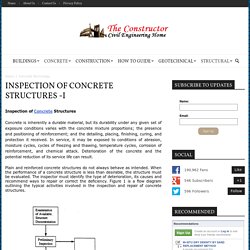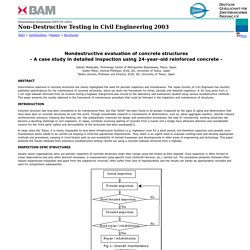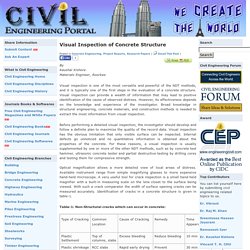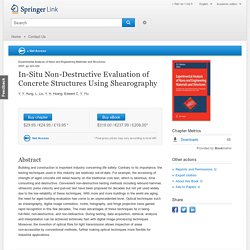

Visual Inspection - GBG. INSPECTION OF CONCRETE STRUCTURES -I. Concrete is inherently a durable material, but its durability under any given set of exposure conditions varies with the concrete mixture proportions; the presence and positioning of reinforcement; and the detailing, placing, finishing, curing, and protection it received.

In service, it may be exposed to conditions of abrasion, moisture cycles, cycles of freezing and thawing, temperature cycles, corrosion of reinforcement, and chemical attack. Deterioration of the concrete and the potential reduction of its service life can result. Plain and reinforced concrete structures do not always behave as intended. Nondestructive evaluation of concrete structures - A case study in detailed inspection using 24-year-old reinforced concrete. Satoko Watanabe, Technology Center of Metropolitan Expressway, Tokyo, Japan Sudhir Misra, Visiting Professor, ICUS, IIS, University of Tokyo, Japan Taketo uomoto, Professor and Director, ICUS, IIS, University of Tokyo, Japan Deterioration observed in concrete structures has clearly highlighted the need for periodic inspection and maintenance.

The Japan Society of Civil Engineers has recently published specifications for the maintenance of concrete structures, which lay down the framework for initial, periodic and detailed inspection. A 3m long piece from a 1.2m high sidewall removed from its location during a highway realignment was moved to the laboratory and extensively studied using various nondestructive methods. Visual Inspection of Concrete Structure. By Kaushal Kishore Materials Engineer, Roorkee Visual inspection is one of the most versatile and powerful of the NDT methods, and it is typically one of the first steps in the evaluation of a concrete structure.

Visual inspection can provide a wealth of information that may lead to positive identification of the cause of observed distress. However, its effectiveness depends on the knowledge and experience of the investigator. Broad knowledge in structural engineering, concrete materials, and construction methods is needed to extract the most information from visual inspection. Before performing a detailed visual inspection, the investigator should develop and follow a definite plan to maximize the quality of the record data. Table-1: Non-Structural cracks which can occur in concrete: Psi_pe.pdf. Strength Evaluation of Concrete Structures. Tensile Strength 1.3.2 Compressive Strength: Compressive strength is the capacity of a or structure to withstand axially directed pushing forces.

It provides data (or a plot) of force vs deformation for the conditions of the test method. 1.3.3 Tensile Strength: The resistance of a material to breaking under tension 2.1 Compressive strength 2.1.1WHY is Compressive Strength Determined? Compressive strength test results are primarily used to determine that the concrete mixture as. Probabilistic Evaluation of Service Life for Reinforced Concrete Structures. C9. In-Situ Non-Destructive Evaluation of Concrete Structures Using Shearography. Building and construction is important industry concerning life safety.

Contrary to its importance, the testing techniques used in this industry are relatively out-of-date. For example, the accessing of strength of aged concrete still relied heavily on the traditional core test, which is laborious, time consuming and destructive. Convenient non-destructive testing methods including rebound hammer, ultrasonic pulse velocity and pull-out test have been proposed for decades but not yet used widely due to the low reliability of these techniques. With more and more buildings in the world are aging, the need for aged building evaluation has come to an unprecedented level.
Optical techniques such as shearography, digital image correlation, moiré, holography, and fringe projection have gained rapid recognition in this few decades. In-Situ Load Testing of Concrete Structures, Part 1. Rationale, Objectives, and Execution While it is usually possible to demonstrate the safety of an existing structure through calculations based on general accepted engineering principles, this is not always the case.

Sometimes there are structures for which calculations alone may not be sufficient to demonstrate fitness for intended occupancy or use. In such situations, in-situ load testing can provide valuable information about the performance of existing structures, and can take advantage of beneficial structural behavior not readily apparent with conventional computational methods. The primary goal of load testing is to demonstrate the safety of a structure.
Load tests do not determine the design strength or load-carrying limit. An Error Occurred Setting Your User Cookie. Structural_review_checklist.pdf.